Five hoof-care professionals were honored for their outstanding careers during the Halls of Fame induction ceremony at the 21st annual International Hoof-Care Summit in Cincinnati, Ohio.
Farriers Henry Asmus, Billy Lewis, Derek Poupard and Patrick Reilly joined the International Horseshoeing Hall of Fame, while Ron Genovese was inducted into the International Equine Veterinarian Hall of Fame.
International Horseshoeing Hall of Fame
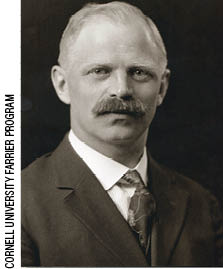
Henry Asmus
Professor Henry Asmus was the founding instructor at the Cornell University Farrier School in 1913. He studied under Anton Lungwitz in his native Germany and migrated to the United States after being recruited for the Cornell farrier position because of his extensive knowledge in remedial farriery.
Asmus was well known for his ability to shoe draft horses that were used for everyday transportation and keep them going with various unique horseshoe modifications. There is an extensive collection of these shoes in the Cornell Farrier Shop (see this month's "What's This?"). He published a listing of these horseshoes, which is titled, “Horseshoes of Interest to Veterinarians.”
“Having the privilege of being in the farrier shop at Cornell University and being under that awesome collection of shoes is very inspiring,” says Steve Kraus, head of Farrier Services and senior lecturer for large animal surgery at Cornell, while accepting the honor. “I wish I could have met and worked with him, but I feel his presence amongst those horseshoes in our collection.”
He also published “Farm Horse Shoeing,” and many bulletins about farriery for the U.S. Department of Agriculture. Asmus was also hired by the War Department during World War I to advise the army about shoeing military horses and mules.
Asmus taught veterinary students at Cornell about the many ways to understand lameness and provide farriery cures. He also provided many lectures to co-operative extension services to teach farmers how to better care for their horses. He was a groundbreaker for the farrier profession in the United States.
“It’s a great day for them. Interestingly enough, Henry Asmus’ great granddaughter is headed to veterinary college and wants to be an equine practitioner,” Kraus says. “So, it runs in the family. His family is overjoyed for this recognition of their family member.”
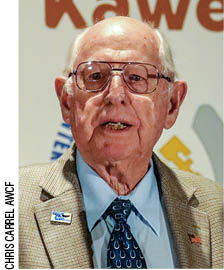
Billy Lewis
Billy Lewis has left an immeasurable mark on the farrier industry worldwide. Shoeing horses throughout central Alabama for more than 60 years and competing at farrier competitions across the U.S. Lewis has influenced, encouraged and helped farriers everywhere he’s been. He’s a highly regarded farrier in the U.S., but his influence has crossed our borders on many occasions through hosting cultural exchange participants and competitions in Calgary and at the American Farrier’s Association (AFA) Convention.
Even in his 70s, Lewis still begins each day at 4 a.m., reading his Bible and then seeking articles and texts on farriery. So many of those whom he has been a mentor to are inspired by his lifelong journey, yet still seeking knowledge at this season of his career.
Lewis competed at the World Championship Blacksmiths’ Competition in Calgary, Alberta, many times, including making the team with industry icons Bob Marshall, Dave Duckett and Mike Miller to form the “Golden Oldies” team at the last World Champion Blacksmiths’ Competition at the Calgary Stampede. He has taught and organized many clinics throughout the U.S. and lectured at AFA conventions. He is a great horseman, teacher, mentor and friend to so many farriers around the globe.
“It never crossed my mind that I would be standing on this stage,” Lewis says while accepting the honor. “It’s not something you work for. It’s something that you live this great profession to be if you possibly can.”
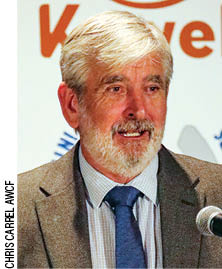
Derek Poupard
Derek Poupard started trimming horses when he was 14 years old in South Africa, and 18 when he started his apprenticeship. He built his business with five people working for him as he shod racehorses.
In 1995, he was blown away by the educational approach of horseshoeing while attending the American Farrier’s Association Convention. It was the completely different way and approach of working that inspired him.
Since then, Poupard traveled around the world, working in the United States, Dubai and the United Kingdom on some of the best horses in the world. He is an innovator who has invented the 3D HoofCare pads, HoofCast and many others. Poupard started a barefoot program in Dubai on racehorses with compromised feet. The results included winning multiple Derbys, Breeders Cups and Classic Grade 1 races, including the 2021 Horse of the Year.
“When I started at 14 years old, my mother said if you’re going to be a farrier, be the best, and always go the extra mile,” Poupard says. “That’s the biggest take-home message — go the extra mile in what you’re doing and you will achieve what you want to achieve.”
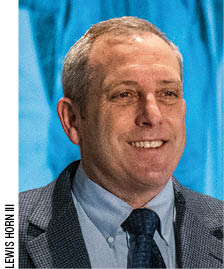
Patrick Reilly
Patrick Reilly served as the resident farrier at Rochester Equine Clinic in Rochester, N.H., and practiced at Reilly Farrier Service before moving to the University of Pennsylvania in 2006, where he is chief of Farrier Services and director of the Applied Polymer Research Laboratory at New Bolton Center.
During his time at Penn, not only has Reilly expanded on the work of the Hall of Fame farrier Rob Sigafoos with adhesive technology in farriery, but he has also pioneered the use of an in-shoe force measurement system and recently published his peer-reviewed research.
He graduated from the Royal Veterinary College with a Graduate Diploma in Equine Locomotor Research. He has co-authored works published in Equine Veterinary Journal and the Journal of Equine Veterinary Science. Reilly has contributed to numerous publications and podcasts throughout his career for the horse owner, farrier, and veterinarian. In 2022, Reilly was appointed to and continues to serve on the Horseracing Integrity and Safety Authority’s Racetrack Safety Standing Committee.
“It’s really special to be recognized by your peers,” Reilly says. “I can’t say that I expected this in any kind of way. Everyone in this room puts their blood, sweat and tears into what they do, and trying to be better. I have a sign quoting Albert Einstein hanging up in my shop that says, ‘If we knew what we’re doing, we wouldn’t need to do research.’ Every time I’ve been up on this stage, or anytime I lecture anywhere, I’m echoing that sentiment. I wish I could say that I’m a good farrier. I’d like to say that I’m better than I used to be. I’ve never felt like I was all that talented, but we all work hard at it.”
International Equine Veterinarian Hall of Fame
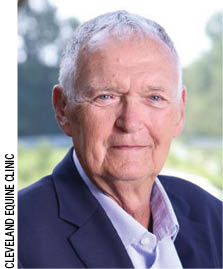
Dr. Ron Genovese
One of the first concepts that Dr. Ron Genovese vehemently and persistently impresses upon young veterinary students under his tutelage is the importance of a healthy working relationship between veterinarians and farriers. Virtually every case that came into the Cleveland Equine Clinic was a case history followed by the question, “Now, who is your farrier?” Inevitably, at some point in the case work-up, he would compliment the client regarding either the trim or shoeing that the farrier had implemented. Genovese believes and practices that without the farrier, many of the cases that he works on would not get better, and it takes a collaborative effort to make a horse sound.
Genovese regularly would have various farriers voluntarily and spontaneously spend the day with him at the clinic learning collaboratively. He and the farrier would take time away from a case, discuss other shoeing options or techniques, discuss the radiographs, and then move forward with the case. The multitude of farriers who would come for a day when they were in town or driving by, was frequent and everyone was welcomed warmly and treated as equals.
To this day, there is not a specific or stand-alone farrier who works out of the Cleveland Equine Clinic. This was implemented by Genovese. All are welcome and it’s understood that the working relationship between veterinarians and farriers is imperative to accomplishing the client’s goals for the horse.
Genovese has played an instrumental role and participant within the National Alliance of Equine Practitioners (formerly the Northeast Association of Equine Practitioners), whose mission statement embodies the veterinary-farrier relationship. He lectures and often volunteers his time to speak with local and statewide farrier organizations to discuss cases and pathology so that there is a constant level of understanding between professions.
“I am so honored by this award and, in reality, being recognized by an elite farrier organization such as yours is especially humbling,” Genovese says. “In my over 50 years of the practice of equine veterinary medicine in the ‘trenches,’ my education and relationships with some great farriers broadened my understanding of the needs of care of the foot for the well-being of the horse. The winner of course is the horse, as it should be. I am quite humbly honored to have my name placed among the fantastic list of inductees that your organization has honored. I thank you for this honor, which I will treasure.”
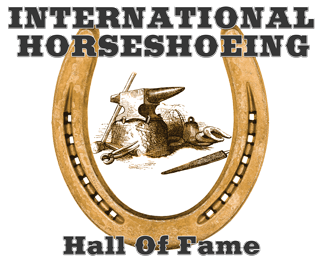
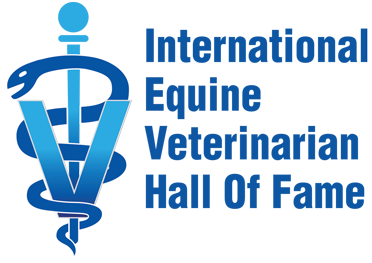
How to Nominate
The deadline for nominating worthy farriers and equine veterinarians for each of the two Halls of Fame is July 31, 2024. To nominate a farrier or equine veterinarian, please complete the online form at AmericanFarriers.com/HOFNomination.

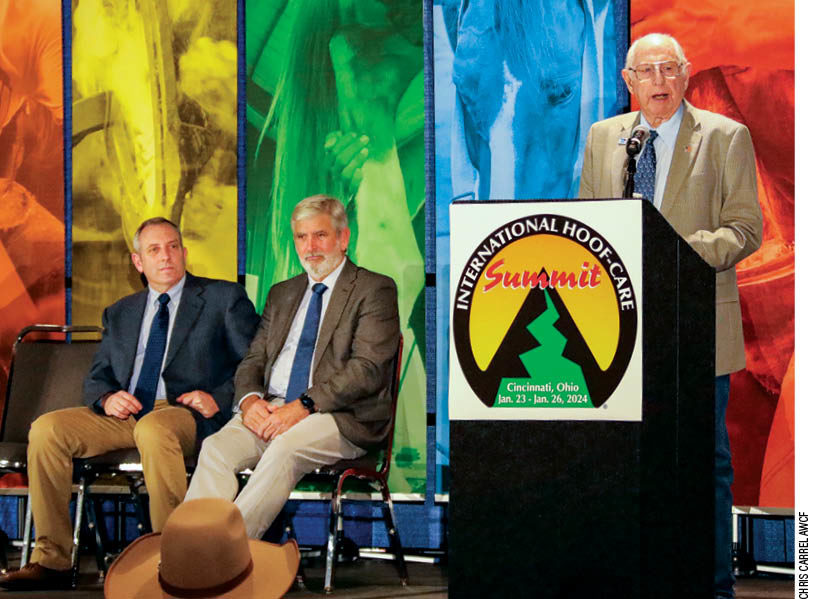






Post a comment
Report Abusive Comment